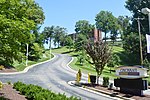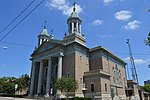Police Station No. 3 (Cincinnati, Ohio)

Police Station No. 3 is a registered historic building in Cincinnati, Ohio, listed in the National Register on May 18, 1981. The Cincinnati Police Station at 3201 Warsaw Avenue opened December 31, 1908. It was a combined station house and patrol house, which accommodated 40 patrolmen, a patrol wagon, and 16 horses for mounted patrol. Designated the Ninth District and Patrol Nine upon opening, it was re-designated as District 3 in 1927. On December 14, 2008, community groups joined with the police department and the Greater Cincinnati Police Historical Society to celebrate the building's centennial. A plaque on front of the building commemorates that event. District 3's operations moved from this building to a new station in June 2015. The station on Warsaw Avenue station is still used by Cincinnati Police Traffic Units.
Excerpt from the Wikipedia article Police Station No. 3 (Cincinnati, Ohio) (License: CC BY-SA 3.0, Authors, Images).Police Station No. 3 (Cincinnati, Ohio)
Warsaw Avenue, Cincinnati East Price Hill
Geographical coordinates (GPS) Address Nearby Places Show on map
Geographical coordinates (GPS)
| Latitude | Longitude |
|---|---|
| N 39.109897222222 ° | E -84.563175 ° |
Address
Warsaw Avenue
45205 Cincinnati, East Price Hill
Ohio, United States
Open on Google Maps








